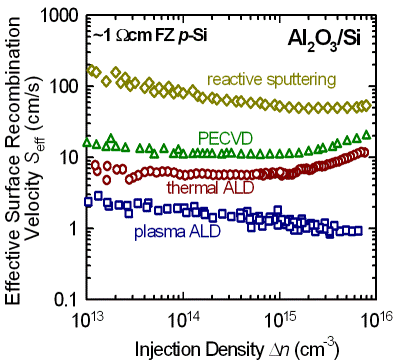 |
Australian National Fabrication Facility |
| Latest News |
September 2010
Photovoltaic solar energy is one of the fastest growing renewable energy technologies that aim to mitigate climate change. It is expected to provide between 5% (according to the International Energy Agency) and 10% (according to the photovoltaic industry) of the world's electricity by the year 2030.
One main driver in solar cell research is to improve their conversion efficiency through the reduction of surface recombination. Traditionally, thermally grown SiO2 @ 1,000°C has been used in the labs for such purpose; however there is an industrial drive to do the passivation at much lower temperature. As a consequence, plasma deposited SiNX is commonly used to passivate the phosphorus doped emitter region of Si solar cells. Moreover, the SiNX layer is simultaneously used as an anti-reflection coating (ARC). Passivating the rear, p-type side of the wafers, remains a challenge for the industry. Recent work has shown that it is best passivated with atomic layer deposition (ALD) of Al2O3, which is negatively charged in opposition to the positively charged SiNX layer. Unfortunately ALD is not yet a high throughput process, although there are already reports of newly designed machines that can perform thermal ALD at high rates.
At the ANU College of Engineering & Computer Science, School of Engineering, one of the primary goals of the PhD research performed over the last three years by Andrew Li, under the supervision of Prof. Andres Cuevas, was to find an alternative method to deposit the dielectric layer of Al2O3. Andrew investigated the sputtering of Al2O3 films using the ANFF ACT Node flagship AJA Sputter system, comparing the reactive sputtering using Al target + O2 gas versus an Al2O3 target. The chart below shows this property of the sputtered Al2O3 as compared to other deposition methods for the same dielectric. After detailed optimisation of the deposition conditions, reactive RF sputtering gave the best results. A good way of quantifying the effectiveness of the passivation is by measuring the surface recombination velocity: the lower, the better the passivation.
 |
 |
Andrew Li depositing Al2O3 by sputtering at the ANFF ACT Node at ANU |
Surface recombination velocity of the reactive sputtering in comparison to other dielectrics. |
Although the sputtered Al2O3 does not perform as well as the other methods, particularly the ALD Al2O3, the efficiency of the solar cells jointly made by the Institut für Solarenergieforschung Hameln (ISFH) and ANU reached a confirmed value of 20.1%, thus demonstrating the potential of reactive sputtering as a suitable technique to passivate the p-type rear surface of advanced Si-solar cells. A further application of the method to boron diffused front emitters, such as those needed for n-wafer solar cells, will be the next challenge.
Andrew Li has submitted his thesis and is now working for the Renewable Energy Corporation (REC), a solar cell company based in Singapore.
|
||
 |
||
Page last updated:
6 November, 2014
|
||


